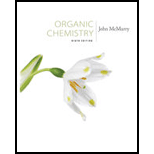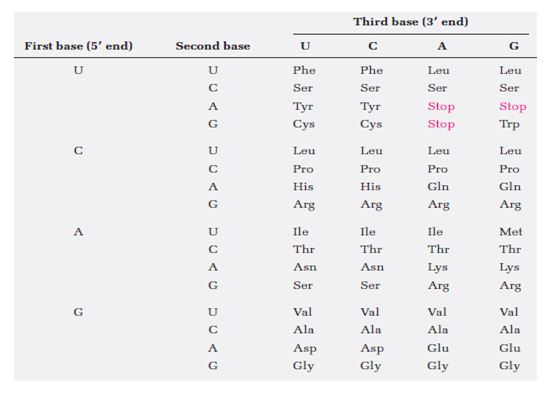
Concept explainers
a)
Interpretation:
List anticodon sequence on the tRNAs of the given amino acids.
AAU
Concept introduction:
The main function of messenger RNA (mRNA) is to give the direction to biosynthesis of thousands of diverse peptides and proteins required by organisms. The mechanics of protein biosynthesis take place on ribosomes, small granular particles in the cytoplasm of a cell that consist of 60% ribosomal RNA and 40% protein.
The specific sequence of mRNA forms a message which determines the sequences of amino acid residues which are to be joined known as “codon”. Each “word” or codon consist of three ribonucleotides that is specific for a given amino acid. The message embedded in mRNA is read by transfer RNA (tRNA) in a process called translation.
Codon assignments of base triplets are given below:

Note: The bounded amino acid sequence is always written from 5’→3’ direction. The codon sequences on mRNA are read by tRNA which are having complementary anticodon base.
Answer to Problem 28AP
The anticodon sequence on the tRNAs of the amino acids are given below:
Note: As in the previous question (80485-28-27AP), the codon sequences formed are the mRNAs and hence the complement of mRNAs will give rise tRNAs.
AAU
| Codon Sequence (mRNA) | Anticodon Sequence (tRNA) |
| (5’)-AAU-(3’) | (5’)-AUU-(3’) |
Explanation of Solution
As the anticodon sequence on tRNAs are the complement of the mRNAs, therefore, we will just replace A by U, G by C, U by A and C by G. The number of sequence of anticodon will remain same as that of the codons.
The anticodon sequence on the tRNAs of the amino acids are given below:
Note: As in the previous question (80485-28-27AP), the codon sequences formed are the mRNAs and hence the complement of mRNAs will give rise tRNAs.
AAU
| Codon Sequence (mRNA) | Anticodon Sequence (tRNA) |
| (5’)-AAU-(3’) | (5’)-AUU-(3’) |
b)
Interpretation:
List anticodon sequence on the tRNAs of the given amino acids.
GAG
Concept introduction:
The main function of messenger RNA (mRNA) is to give the direction to biosynthesis of thousands of diverse peptides and proteins required by organisms. The mechanics of protein biosynthesis take place on ribosomes, small granular particles in the cytoplasm of a cell that consist of 60% ribosomal RNA and 40% protein.
The specific sequence of mRNA forms a message which determines the sequences of amino acid residues which are to be joined known as “codon”. Each “word” or codon consist of three ribonucleotides that is specific for a given amino acid. The message embedded in mRNA is read by transfer RNA (tRNA) in a process called translation.
Codon assignments of base triplets are given below:

Note: The bounded amino acid sequence is always written from 5’→3’ direction. The codon sequences on mRNA are read by tRNA which are having complementary anticodon base.
Answer to Problem 28AP
The anticodon sequence on the tRNAs of the amino acids are given below:
Note: As in the previous question (80485-28-27AP), the codon sequences formed are the mRNAs and hence the complement of mRNAs will give rise tRNAs.
GAG
| Codon Sequence (mRNA) | Anticodon Sequence (tRNA) |
| (5’)-GAG-(3’) | (5’)-CUC-(3’) |
Explanation of Solution
As the anticodon sequence on tRNAs are the complement of the mRNAs, therefore, we will just replace A by U, G by C, U by A and C by G. The number of sequence of anticodon will remain same as that of the codons.
The anticodon sequence on the tRNAs of the amino acids are given below:
Note: As in the previous question (80485-28-27AP), the codon sequences formed are the mRNAs and hence the complement of mRNAs will give rise tRNAs.
GAG
| Codon Sequence (mRNA) | Anticodon Sequence (tRNA) |
| (5’)-GAG-(3’) | (5’)-CUC-(3’) |
c)
Interpretation:
List anticodon sequence on the tRNAs of the given amino acids.
UCC
Concept introduction:
The main function of messenger RNA (mRNA) is to give the direction to biosynthesis of thousands of diverse peptides and proteins required by organisms. The mechanics of protein biosynthesis take place on ribosomes, small granular particles in the cytoplasm of a cell that consist of 60% ribosomal RNA and 40% protein.
The specific sequence of mRNA forms a message which determines the sequences of amino acid residues which are to be joined known as “codon”. Each “word” or codon consist of three ribonucleotides that is specific for a given amino acid. The message embedded in mRNA is read by transfer RNA (tRNA) in a process called translation.
Codon assignments of base triplets are given below:

Note: The bounded amino acid sequence is always written from 5’→3’ direction. The codon sequences on mRNA are read by tRNA which are having complementary anticodon base.
Answer to Problem 28AP
The anticodon sequence on the tRNAs of the amino acids are given below:
Note: As in the previous question (80485-28-27AP), the codon sequences formed are the mRNAs and hence the complement of mRNAs will give rise tRNAs.
UCC
| Codon Sequence (mRNA) | Anticodon Sequence (tRNA) |
| (5’)-UCC-(3’) | (5’)-GGA-(3’) |
Explanation of Solution
As the anticodon sequence on tRNAs are the complement of the mRNAs, therefore, we will just replace A by U, G by C, U by A and C by G. The number of sequence of anticodon will remain same as that of the codons.
The anticodon sequence on the tRNAs of the amino acids are given below:
Note: As in the previous question (80485-28-27AP), the codon sequences formed are the mRNAs and hence the complement of mRNAs will give rise tRNAs.
UCC
| Codon Sequence (mRNA) | Anticodon Sequence (tRNA) |
| (5’)-UCC-(3’) | (5’)-GGA-(3’) |
d)
Interpretation:
List anticodon sequence on the tRNAs of the given amino acids.
CAU
Concept introduction:
The main function of messenger RNA (mRNA) is to give the direction to biosynthesis of thousands of diverse peptides and proteins required by organisms. The mechanics of protein biosynthesis take place on ribosomes, small granular particles in the cytoplasm of a cell that consist of 60% ribosomal RNA and 40% protein.
The specific sequence of mRNA forms a message which determines the sequences of amino acid residues which are to be joined known as “codon”. Each “word” or codon consist of three ribonucleotides that is specific for a given amino acid. The message embedded in mRNA is read by transfer RNA (tRNA) in a process called translation.
Codon assignments of base triplets are given below:

Note: The bounded amino acid sequence is always written from 5’→3’ direction. The codon sequences on mRNA are read by tRNA which are having complementary anticodon base.
Answer to Problem 28AP
The anticodon sequence on the tRNAs of the amino acids are given below:
Note: As in the previous question (80485-28-27AP), the codon sequences formed are the mRNAs and hence the complement of mRNAs will give rise tRNAs.
CAU
| Codon Sequence (mRNA) | Anticodon Sequence (tRNA) |
| (5’)-CAU-(3’) | (5’)-AUG-(3’) |
Explanation of Solution
As the anticodon sequence on tRNAs are the complement of the mRNAs, therefore, we will just replace A by U, G by C, U by A and C by G. The number of sequence of anticodon will remain same as that of the codons.
The anticodon sequence on the tRNAs of the amino acids are given below:
Note: As in the previous question (80485-28-27AP), the codon sequences formed are the mRNAs and hence the complement of mRNAs will give rise tRNAs.
CAU
| Codon Sequence (mRNA) | Anticodon Sequence (tRNA) |
| (5’)-CAU-(3’) | (5’)-AUG-(3’) |
Want to see more full solutions like this?
Chapter 28 Solutions
Organic Chemistry - With Access (Custom)
- 4. Calculate the total number of sigma bonds and total number of pi bonds in each of the following compounds. a. HH :D: +1 I H-N-C-C-O-H I H b. HH H Н :N=C-C-C=C-CEC-H :0: total o H-C-H H-C = `C-H I H. 11 H-C = C= CH H total o total π total π 1 Harrow_forwardIn the following reaction, what quantity in moles of CH₃OH are required to give off 4111 kJ of heat? 2 CH₃OH (l) + 3 O₂ (g) → 2 CO₂ (g) + 4 H₂O(g) ∆H° = -1280. kJarrow_forwardIndicate the processes in the dismutation of Cu2O.arrow_forward
- 1. Consider these three reactions as the elementary steps in the mechanism for a chemical reaction. 2600 2400 2200 2000 1800 1600 1400 1200 1000 800 Potential Energy (kJ) 600 400 200 0 -200- -400 -600- -800 (i) Cl₂ (g) + Pt(s) → 2Cl (g) + Pt(s) (ii) Cl (g)+ CO (g) + Pt (s) → CICO (g) + Pt (s) Ea = 1550 kJ Ea = 2240 kJ (iii) Cl (g) + CICO (g) → Cl₂CO (g) Ea = 2350 kJ AH=-950 kJ ΔΗ = 575 ΚΙ AH=-825 kJ a. Draw the potential energy diagram for the reaction. Label the data points for clarity. The potential energy of the reactants is 600 kJ Reaction Progress b. What is the overall chemical equation? c. What is the overall change in enthalpy for the above chemical reaction? d. What is the overall amount of activation energy for the above chemical reaction? e. Which reaction intermediate would be considered a catalyst (if any) and why? f. If you were to add 2700kJ of energy to the reaction (e.g. 2700 kl of heat or electricity), would you be able to make the reaction reverse itself (i.e. have…arrow_forwarddraw the enolate anion and the carbonyl that would be needed to make this product through an aldol addition reaction.arrow_forwardDraw the Michael Adduct and the final product of the Robinson annulation reaction. Ignore inorganic byproducts.arrow_forward
- Draw the Michael adduct and final product of the Robinson annulation reaction. Ignore inorganic byproductsarrow_forwardPost Lab Questions. 1) Draw the mechanism of your Diels-Alder cycloaddition. 2) Only one isomer of product is formed in the Diels-Alder cycloaddition. Why? 3) Imagine that you used isoprene as diene - in that case you don't have to worry about assigning endo vs exo. Draw the "endo" and "exo" products of the Diels-Alder reaction between isoprene and maleic anhydride, and explain why the distinction is irrelevant here. 4) This does not hold for other dienes. Draw the exo and endo products of the reaction of cyclohexadiene with maleic anhydride. Make sure you label your answers properly as endo or exo. 100 °C Xylenes ??? 5) Calculate the process mass intensity for your specific reaction (make sure to use your actual amounts of reagent).arrow_forwardIndicate the product(s) A, B C and D that are formed in the reaction: H + NH-NH-CH [A+B] [C+D] hydrazonesarrow_forward
- How can you prepare a 6 mL solution of 6% H2O2, if we have a bottle of 30% H2O2?arrow_forwardHow many mL of H2O2 from the 30% bottle must be collected to prepare 6 mL of 6% H2O2.arrow_forwardIndicate the product(s) B and C that are formed in the reaction: HN' OCH HC1 B + mayoritario C minoritario OCH3arrow_forward

 General, Organic, and Biological ChemistryChemistryISBN:9781285853918Author:H. Stephen StokerPublisher:Cengage Learning
General, Organic, and Biological ChemistryChemistryISBN:9781285853918Author:H. Stephen StokerPublisher:Cengage Learning Organic And Biological ChemistryChemistryISBN:9781305081079Author:STOKER, H. Stephen (howard Stephen)Publisher:Cengage Learning,
Organic And Biological ChemistryChemistryISBN:9781305081079Author:STOKER, H. Stephen (howard Stephen)Publisher:Cengage Learning, Chemistry & Chemical ReactivityChemistryISBN:9781133949640Author:John C. Kotz, Paul M. Treichel, John Townsend, David TreichelPublisher:Cengage Learning
Chemistry & Chemical ReactivityChemistryISBN:9781133949640Author:John C. Kotz, Paul M. Treichel, John Townsend, David TreichelPublisher:Cengage Learning Chemistry for Today: General, Organic, and Bioche...ChemistryISBN:9781305960060Author:Spencer L. Seager, Michael R. Slabaugh, Maren S. HansenPublisher:Cengage Learning
Chemistry for Today: General, Organic, and Bioche...ChemistryISBN:9781305960060Author:Spencer L. Seager, Michael R. Slabaugh, Maren S. HansenPublisher:Cengage Learning Introduction to General, Organic and BiochemistryChemistryISBN:9781285869759Author:Frederick A. Bettelheim, William H. Brown, Mary K. Campbell, Shawn O. Farrell, Omar TorresPublisher:Cengage Learning
Introduction to General, Organic and BiochemistryChemistryISBN:9781285869759Author:Frederick A. Bettelheim, William H. Brown, Mary K. Campbell, Shawn O. Farrell, Omar TorresPublisher:Cengage Learning





